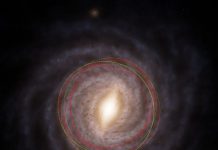
In a recent groundbreaking discovery, astronomers have observed a massive galaxy from over 11 billion years ago, hosting stars far older than theories of galaxy formation and the nature of dark matter would suggest.
This ancient stellar population, observed to be larger than our Milky Way, challenges the current understanding of how galaxies form in the early universe.
The findings, detailed in a publication in Nature, come from the James Webb Space Telescope (JWST), which peered back in time to a cosmic redshift of 3.2, equivalent to 11.5 billion years ago.
Astonishingly, the galaxy houses stars that formed about 1.5 billion years earlier than the observation point, at a redshift around 11. This contradicts the prevailing models that suggest dark matter needs to accumulate in significant concentrations before it can seed galaxy formation.
Led by Distinguished Professor Karl Glazebrook from Swinburne University of Technology, the international research team embarked on a seven-year quest to unravel the mysteries of this galaxy.
Previous attempts with the largest telescopes on Earth were hindered by the galaxy’s faintness and redness, making it difficult to measure its age accurately. The breakthrough came with the JWST, which provided the necessary data to confirm the galaxy’s surprising nature.
The observation challenges the fundamental principles of modern astrophysics, which predict a decline in the number of massive galaxies in the universe’s infancy.
The existence of such a massive quiescent galaxy, having ceased star formation only one to two billion years after the Big Bang, puts into question the theoretical models that have been long accepted.
The team’s collaborative effort spanned from initial infrared sky surveys to intensive data analysis of JWST’s spectroscopic observations.
Dr. Themiya Nanayakkara played a pivotal role in analyzing the spectral data, emphasizing the challenge of confirming the existence of such ancient, massive galaxies and the implications for our understanding of galaxy formation and evolution.
Associate Professor Claudia Lagos, involved in developing the theoretical models for dark matter concentrations, highlighted the significant challenges these observations pose to the standard model of cosmology.
The early formation of such massive galaxies suggests that dark matter structures capable of hosting them may have formed much earlier than previously thought.
This discovery has the potential to revolutionize our understanding of dark matter physics. With the JWST continuing to uncover evidence of massive galaxies forming early in the universe’s history, further observations are crucial.
These findings may not only confirm the existence of more such galaxies but also prompt a reevaluation of our theories on galaxy formation, challenging the established cosmological models and opening new avenues for research into the mysteries of the cosmos.
The research findings can be found in Nature.
Copyright © 2024 Knowridge Science Report. All rights reserved.



